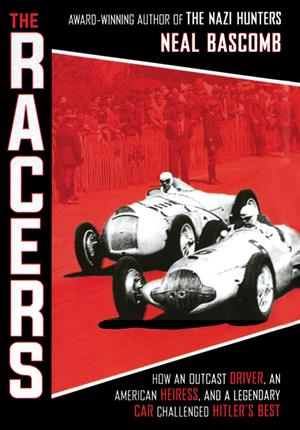| Racers : how an outcast driver, an American heiress, and a legendary car challenged Hitler's best Author: Bascomb, Neal | ||
| Price: $6.50 | ||
Summary:
Before World War II, Adolf Hitler wanted to prove the greatness of the Third Reich in everything from track and field to motorsports. With a stable of supercharged automobiles called Silver Arrows, their drivers dominated the sensational world of European Grand Prix racing. So in 1937, Lucy Schell, an American heiress and top Monte Carlo Rally driver, hired Rene Dreyfus, a Jewish Frenchman, to take on the Silver Arrows as the world held its breath in anticipation of who would triumph.
Video Preview:
| Accelerated Reader Information: Interest Level: MG+ Reading Level: 7.70 Points: 9.0 Quiz: 510222 |
Reviews:
Kirkus Reviews (-) (08/01/20)
School Library Journal (+) (11/01/20)
Booklist (+) (09/01/20)
The Bulletin of the Center for Children's Books (+) (12/01/20)
Full Text Reviews:
School Library Journal - 11/01/2020 Gr 7 Up—Masterly history detective Bascomb provides a fascinating chronicle of the European grand prix racing scene during the 1930s. The text focuses on German driver Rudi Caracciola, who drove for the Nazi-sponsored team, and "the outcast" French driver René Dreyfus, who was excluded from the German teams because he was Jewish. Also integral to the story is Lucy Schell, an American heiress who hired Dreyfus to drive her team's French Delahaye 145 against the German Mercedes Silver Arrow cars, which dominated grand prix racing at that time. The rivalry between Dreyfus and Caracciola parallels the rising conflict between France and Germany. The Nazi party strategically used grand prix racing as a propaganda tool to assert its military and ethnic "superiority." Bascomb's descriptive details, such as the ache in Caracciola's leg from shifting gears and how Dreyfus triple tied his shoes prior to a race, will engage readers. The riveting black-and-white photographs and direct quotes included throughout bring the characters and events to life. Readers who have no prior knowledge of automobile racing will still recognize the names of prominent car manufacturers (Mercedes, Bugatti, Maserati, and Alfa Romeo). At the end of the text, Bascomb describes his research methods using primary and secondary documents and provides an extensive source list. Some middle grade readers may struggle with the French and German names and mechanical terms, but most will be motivated to persevere given the compelling story line. VERDICT Highly recommended for middle and high school students who enjoy narrative nonfiction and sports history.—Maile Steimer, Jones M.S., Buford, GA - Copyright 2020 Publishers Weekly, Library Journal and/or School Library Journal used with permission.



